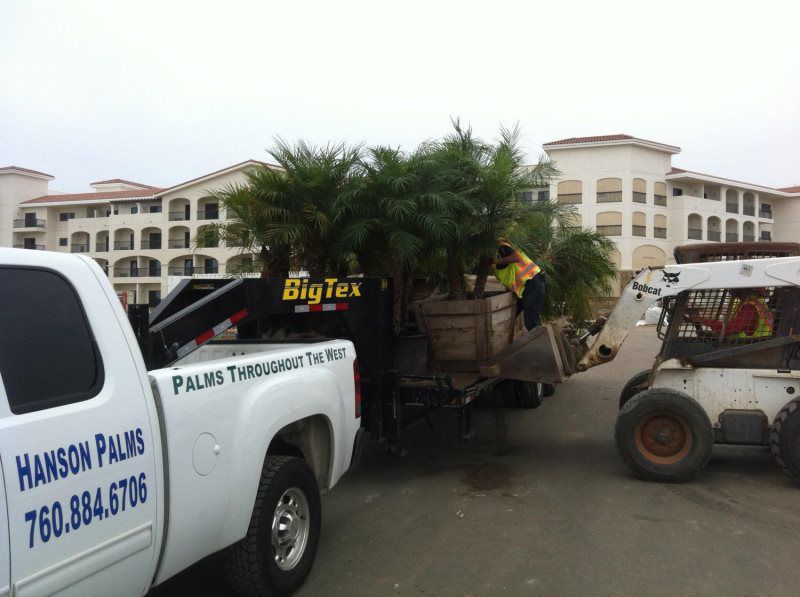PALM GUIDES & TIPS

SPECIMEN PALM PROCUREMENT AND INSTALLATION TIPS
By Jerry Hanson, Hanson Palms
The purchasing of large palms and the installation of large specimen palms pose a series of unique challenges to landscape contractors. Due to the large expenditure of funds and intensive labor and equipment expenses, most projects demand extensive pre-planning to ensure a profitable outcome. In examining your company’s readiness for large scale projects, there are three basic areas to investigate when beginning.
EQUIPMENT & PERSONNEL
The profit margin is clear, but is your staff experienced enough to understand the planting procedure? Remember, palms do not reflect damage done during planting until months after installation. The cost of replacing them can run into the thousands of dollars, stressing the day-to-day operating budgets and creating extensive stress between client and contractor.
Here are a few tips for avoiding this problem:
Begin by hiring only experienced equipment operators. A good choice would be outsource crane operators that specialize in planting large specimen palms.
Always use larger cranes or equipment than what is specified. One hour of expense for larger equipment, compared to one day lost waiting for the right equipment, is definitely worth it.


Allow ample time to plant. Acting in haste leads to accidents.
Discuss with equipment operators exactly how you want to position the palms.
Pay close attention to planting depths. Once the equipment is no longer on the job site, the palm planting depth is set.
Remember that not all palms, even though being identical in brown trunk height, will appear identical in height once planted. Be sure to adjust for any discrepancies during installation and turn the palms with the most aesthetic side facing out.
Arrange for large scale plantings on Tuesday through Thursday, if possible. This allows time for delays or unforeseen circumstances that may come up.
Get help. If your staff is not experienced, or simply too busy, many crane companies will plant and install for you.
SPECIFICATIONS AND SELECTION
The area of most importance, without a doubt, is having an understanding of palm measurement. It’s imperative that you understand what the client or architect has in mind when he or she refers to palm height. Brown trunk height is a common height standard on the west coast, however there is also clear trunk and clear wood height. Whenever possible, have the client visit the growing site and personally approve the palms, especially if it is a first time client; digital pictures are just a stepping stone to approval. Large palms generally are not sold contingent on job site acceptance since the expense to return, ship, unload and replant is prohibitive. Always read your invoice and estimates from vendors for their terms of sale.


If you require matching palms (i.e.: palm trunk girth, air roots, and even the shape of the head of the palm) then always specify those requirements in writing when sending out bid requests. Remember, most palms will tolerate being planted with some air roots below the planting grade if necessary. This is accepted procedure especially with Washingtonia robustas (Mexican Fans) and to some extent, all date palms. In some instances, when palms need to be certified by an arborist, allow for that expense as it will most likely not be figured into your vendor's estimate. Certain state agriculture permits are required for palms shipped from parts of California, so be sure to ask that all needed paperwork be attached to your shipper or that your palms be guaranteed until the paperwork can be delivered to the job site. Some companies also offer a foliar drench and a root drench with fungicides and nutrients at a small charge. We recommend this additional purchase as it’s well worth the expense compared to the cost of replacing the palm.
EXTENDED CARE & WARANTIES
Contractors are often asked to back up their installation with warranties as part of the job award specifications and sometimes gain extended maintenance contracts as well. It is a fact that growers and brokers seldom offer a warranty on specimen palms. As most contractors know, fusarium on the Phoenix Canary palms is the leading cause of palm death. Poor drainage and over watering also contribute greatly to problems. Fusarium can be somewhat determined by a tissue culture sample analysis, which is an option available before purchase. Weekly monitoring of drainage by line of sight and pvc tubes (sock covered) can be effective for avoiding over watering.


Quarterly foliar treatments should also be implemented as part of a regular maintenance program. Soil treatment with fungicides should be done every two months for the first year, particularly on Canarys. Also a factor in how the palm reacts to excessive humidity, high temperatures or low temperatures.
Most palms will grow in unfavorable conditions, but none will thrive. In extending warranties, take into account whether the palm is really suited for the job site climate. If not, add a stipulation to that fact. The main point is to prevent all diseases beforehand and to ensure ongoing preventive measures are applied on a regular basis.
